Tuesday, March 29, 2005
Block Island
Saturday promised a pleasant day of sunshine and light winds, apparently a perfect day to get some aerial exercise. Pete was available for a few hours so I planned a quick trip down to the coast to get some cross country time in the log book. I've been to Fishers Island a few times, once as a dual cross country trip during my PPL training, and again with a friend last year, and the idea of a pleasant stroll in a coastal village setting appealed to both Pete and I, but the added interest of visiting an unfamiliar airport drew my attention to the east, towards Block Island. The island is about seven miles long and three miles across, and it sits about 15 miles off the coast of Rhode Island. I knew it only by reputation as a popular tourist destination, but I had never been there, either by land or by sea. I did know that it has an airport, and that was enough to get us started. I planned on a flight time of about 40 minutes. Transiting the narrow band of sky between the airspaces of Westover and Bradley, we passed Springfield, made for the Norwich VOR, and then to the Sandy Point VOR at the Block Island airport. Despite the light winds, it was pretty bumpy at 3,500 feet, as the afternoon sun heated the ground. The resulting thermals meant that a firm hand was required to keep Yellowbird on heading and altitude. The skies were clear, and a slight afternoon haze did little to hinder a good afternoon of sightseeing over southern Massachusetts and central Connecticut.
I planned on a flight time of about 40 minutes. Transiting the narrow band of sky between the airspaces of Westover and Bradley, we passed Springfield, made for the Norwich VOR, and then to the Sandy Point VOR at the Block Island airport. Despite the light winds, it was pretty bumpy at 3,500 feet, as the afternoon sun heated the ground. The resulting thermals meant that a firm hand was required to keep Yellowbird on heading and altitude. The skies were clear, and a slight afternoon haze did little to hinder a good afternoon of sightseeing over southern Massachusetts and central Connecticut. As we crossed the coast and began our descent, the air smoothed considerably, but the CTAF frequency came alive with traffic calls for Block Island and just about every other airport within 100 miles. It took a few minutes to get in my initial report, and I anticipated a busy pattern, but things soon quieted down and we had the pattern to ourselves when we arrived.
As we crossed the coast and began our descent, the air smoothed considerably, but the CTAF frequency came alive with traffic calls for Block Island and just about every other airport within 100 miles. It took a few minutes to get in my initial report, and I anticipated a busy pattern, but things soon quieted down and we had the pattern to ourselves when we arrived. 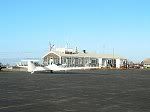 The ramp was well populated with a gaggle of Pipers, a couple of Grummans, a few Cessnas (including a 177RG), a handful of Bonanzas, and a relatively rare Ximango motorglider. The Yellow Truck contacted us on UNICOM as we cleared the runway, and we followed him to one of the few remaining parking spots on the ramp. After paying the $10 landing fee, we set out on foot to explore the island.
The ramp was well populated with a gaggle of Pipers, a couple of Grummans, a few Cessnas (including a 177RG), a handful of Bonanzas, and a relatively rare Ximango motorglider. The Yellow Truck contacted us on UNICOM as we cleared the runway, and we followed him to one of the few remaining parking spots on the ramp. After paying the $10 landing fee, we set out on foot to explore the island.Although the airport was busy, the rest of the island seemed deserted. In an hour's worth of walking, we saw only a few residents, some working in the yard, another walking the baby, and a few out enjoying the almost warm afternoon. Making our way back to the airport, we found ourselves on the wrong side of Great Swamp, so a bit of backtracking, including some discrete shortcuts through a few back yards, was required to get us back to the terminal.
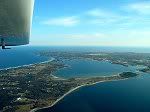 By this time, Bethany's Diner was closed, but we talked them into selling us a couple of sodas before we left. We departed amidst a small flock of other planes, including two of the Pipers, one of the Bonanzas, and the motorglider. The air was smooth and as the pattern cleared out, we took the opportunity to circle the island and do some sightseeing before we headed for the mainland.
By this time, Bethany's Diner was closed, but we talked them into selling us a couple of sodas before we left. We departed amidst a small flock of other planes, including two of the Pipers, one of the Bonanzas, and the motorglider. The air was smooth and as the pattern cleared out, we took the opportunity to circle the island and do some sightseeing before we headed for the mainland.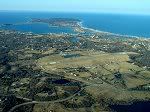 Even in early March, the Island was rich in visual treats, including the intricate coastline, the myriad patches of woods and meadows, and the sometimes jarring juxtaposition of ancient shingle-sided cottages and modern mansions. In the middle of all sits the airport, looking both quaint, with the shingled terminal, and sophisticated, bristling with antennas and weather sensors.
Even in early March, the Island was rich in visual treats, including the intricate coastline, the myriad patches of woods and meadows, and the sometimes jarring juxtaposition of ancient shingle-sided cottages and modern mansions. In the middle of all sits the airport, looking both quaint, with the shingled terminal, and sophisticated, bristling with antennas and weather sensors.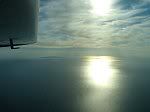 Turning northwards, we climbed to 4,500 feet for our return trip. The late afternoon sun reflected of the waters of Long Island Sound...
Turning northwards, we climbed to 4,500 feet for our return trip. The late afternoon sun reflected of the waters of Long Island Sound...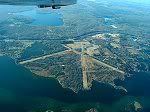 With feet dry again, we took a brief detour to see the old Charlestown Naval Air Station. Very little remains of this historic military base, but the outlines of the runways and taxiways are still much in evidence from the air.
With feet dry again, we took a brief detour to see the old Charlestown Naval Air Station. Very little remains of this historic military base, but the outlines of the runways and taxiways are still much in evidence from the air.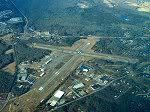 Resuming our homeward trek, we passed Westerly State Airport. Although it's not nearly as busy as Charlestown NAS was in its day, it was still comforting to see an active airfield. (Note the Cessna departing runway 14)
Resuming our homeward trek, we passed Westerly State Airport. Although it's not nearly as busy as Charlestown NAS was in its day, it was still comforting to see an active airfield. (Note the Cessna departing runway 14)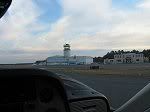 Our return trip was much smoother than the trip down. The lowering sun had little strength to waste on thermal creation, and with Yellowbird trimmed for level flight, I let the autopilot do the flying while Pete and I enjoyed the view and scanned for traffic. Finally, with a little more than two hours on the tachometer, we received clearance for a left downwind for 20. Yellowbird gave us a smooth touchdown and as evening fell, we taxied her back to her familiar tiedown at her own quaint but modern airfield.
Our return trip was much smoother than the trip down. The lowering sun had little strength to waste on thermal creation, and with Yellowbird trimmed for level flight, I let the autopilot do the flying while Pete and I enjoyed the view and scanned for traffic. Finally, with a little more than two hours on the tachometer, we received clearance for a left downwind for 20. Yellowbird gave us a smooth touchdown and as evening fell, we taxied her back to her familiar tiedown at her own quaint but modern airfield.Thursday, March 24, 2005
The Social Airplane
What's more fun than a Cessna Cardinal? How about 4.5 Cessna Cardinals?Saturday provided a rare opportunity to coordinate the schedules of no less than twelve people with a forecast of pleasant weather in order to overwhelm the air traffic controller at a small but busy airport and relieve the stockroom of a pseudo Irish pub of several pounds of hamburger ingredients. It all started when a member of the message board at StudenPilot.com suggested a weekend flyin for those in the New England region. Two weeks of discussion provided us with a date and destination, and the weather looked promising, so plans were made and Yellowbird was spruced up for the trip. We were eagerly looking forward to this outing, since two other Cardinals were expected to be attending.
The day's plan called for an noontime meeting at the small restaurant in the Reliant Air hangar at Danbury Municipal. Informal flyins of this sort are great opportunities to meet other pilots and engage in traditional hangar talk and airplane comparison. They also provide for one of aviation's long-standing traditions, the $100 hamburger. Many airports, large and small, have restaurants either on the field or nearby where hungry pilots can grab a bite between arrival and departure. Prices are usually reasonable, defying the normal pattern for aviation-related expenses, and the food can be worth the cost of getting there. Danbury's eatery currently serves a menu inspired by the traditional Irish pub, and the quality of the offerings has yet to disappoint.
We were fortunate in that the response to the invitation was substantial. Yellowbird and I were also fortunate in that two of the planned attendees were former fledglings of Faithful Instructor George, having successfully left the nest last year. Jamie would be flying his recently purchased Skylane, with Pat riding along as copilot. We made plans to depart at close the same time in hope of meeting up enroute for some air-to-air photography, but that proved to be harder than expected.
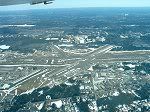 After meeting at the terminal to compare navigation planFs, we prepared for departure. I was off first, departing runway 02 and turned left to a southwesterly heading. Jamie departed a few minutes later from 33. After clearing the class D airspace, I tuned the radio to 122.75, one of the standard air-to-air communication frequencies, and made radio contact with Jamie. He was several miles behind me, so I did a 360 degree turn to give him a chance to catch up. As I rolled out of my turn, Jamie told me that he had me on his TCAS (Traffic Alert & Collision Avoidance System) at a range of three miles. I continued on course and waited for him to close the distance.
After meeting at the terminal to compare navigation planFs, we prepared for departure. I was off first, departing runway 02 and turned left to a southwesterly heading. Jamie departed a few minutes later from 33. After clearing the class D airspace, I tuned the radio to 122.75, one of the standard air-to-air communication frequencies, and made radio contact with Jamie. He was several miles behind me, so I did a 360 degree turn to give him a chance to catch up. As I rolled out of my turn, Jamie told me that he had me on his TCAS (Traffic Alert & Collision Avoidance System) at a range of three miles. I continued on course and waited for him to close the distance. 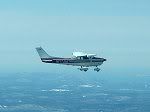 Several minutes later, we still had not made visual contact, but Jamie informed me that he was now a mile or so east of my position. I did another 360, expecting to see him as I returned to my original heading, but he was still nowhere to be seen. Presently he let me know that he was now ahead of me, by a good mile at least. I scanned the area between 10:00 and 11:00 and finally made visual contact. Now it was his turn to mark time while Yellowbird gave her best to catch up with the faster Skylane. Eventually, we met up in a very loose formation, keeping a healthy distance since neither of us had received any training in formation flying. The camera came out, and I managed a couple of good shots of Jamie's big Cessna.
Several minutes later, we still had not made visual contact, but Jamie informed me that he was now a mile or so east of my position. I did another 360, expecting to see him as I returned to my original heading, but he was still nowhere to be seen. Presently he let me know that he was now ahead of me, by a good mile at least. I scanned the area between 10:00 and 11:00 and finally made visual contact. Now it was his turn to mark time while Yellowbird gave her best to catch up with the faster Skylane. Eventually, we met up in a very loose formation, keeping a healthy distance since neither of us had received any training in formation flying. The camera came out, and I managed a couple of good shots of Jamie's big Cessna.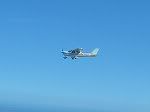 By now, we were close to the point where we would start our descent and make preparations for arrival at Danbury, so we took a westerly detour to give more time for photography. Jamie and I tried our best to keep on a common heading while maintain a comfortable distance, but it wasn't as easy as the military fliers make it look. Fortunately, we tended to diverge rather than converge, and the zoom feature of Pat's camera allowed for a few decent views of the airborne Yellowbird. With the photo op completed, we separated and made for Danbury.
By now, we were close to the point where we would start our descent and make preparations for arrival at Danbury, so we took a westerly detour to give more time for photography. Jamie and I tried our best to keep on a common heading while maintain a comfortable distance, but it wasn't as easy as the military fliers make it look. Fortunately, we tended to diverge rather than converge, and the zoom feature of Pat's camera allowed for a few decent views of the airborne Yellowbird. With the photo op completed, we separated and made for Danbury. Danbury is a fairly small but very busy airport on the southwest side of the city. Surrounded on three sides by hills and ridges, it has a reputation for interesting approaches. Typically for a pleasant Saturday, the pattern was very busy, and the tower controller had his hands full juggling arrivals and departures. Both Jamie and I had to call a couple of times to establish two-way radio contact with the tower. Even then keeping the controller's attention was a competitive effort, with several planes in the pattern vying for his ear. To make matters more interesting, Jamie's Skylane and Yellowbird have very similar registration numbers, with the common digits "774", and there was yet another Cessna in the pattern with "77" in it's registration. How the controller kept us separate is anyone's guess, but we benefited from keeping our eyes out of the cockpit and diligently practicing "see and avoid" procedures.
Danbury is a fairly small but very busy airport on the southwest side of the city. Surrounded on three sides by hills and ridges, it has a reputation for interesting approaches. Typically for a pleasant Saturday, the pattern was very busy, and the tower controller had his hands full juggling arrivals and departures. Both Jamie and I had to call a couple of times to establish two-way radio contact with the tower. Even then keeping the controller's attention was a competitive effort, with several planes in the pattern vying for his ear. To make matters more interesting, Jamie's Skylane and Yellowbird have very similar registration numbers, with the common digits "774", and there was yet another Cessna in the pattern with "77" in it's registration. How the controller kept us separate is anyone's guess, but we benefited from keeping our eyes out of the cockpit and diligently practicing "see and avoid" procedures.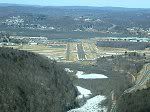 This was particularly important on the base and final legs of the approach to 35, the active runway. Runway 35 is aligned with a narrow valley between two prominent hills immediately south of the field. The terrain effectively blocks the control tower's view of traffic on the base leg and part of the final approach, so extra vigilance is required of pilots to keep safe separation distances. From the pilot's perspective, it's an interesting approach, as you descend between the two hills, and below the level of the hilltops. This was the first time I had flown this approach and my full attention was devoted to flying, but Pat, riding along in Jamie's Skylane, snapped a few good pictures of the final approach.
This was particularly important on the base and final legs of the approach to 35, the active runway. Runway 35 is aligned with a narrow valley between two prominent hills immediately south of the field. The terrain effectively blocks the control tower's view of traffic on the base leg and part of the final approach, so extra vigilance is required of pilots to keep safe separation distances. From the pilot's perspective, it's an interesting approach, as you descend between the two hills, and below the level of the hilltops. This was the first time I had flown this approach and my full attention was devoted to flying, but Pat, riding along in Jamie's Skylane, snapped a few good pictures of the final approach.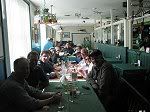 Once safely on the ground, we taxied over to park at the Reliant Air ramp. Most of the gang had already assembled upstairs in the restaurant, and we pulled up a second table to join them. There were a few familiar faces from past flyins, as well as some new faces to connect with the online personalities that we had come to know from the StudenPilot.com message board. Introductions were made, stories were swapped, and many cumulative hours of hangar flying were logged. After eating our fill (and probably throwing a few weight and balance calculations into disarray), we headed outside to see the airplanes.
Once safely on the ground, we taxied over to park at the Reliant Air ramp. Most of the gang had already assembled upstairs in the restaurant, and we pulled up a second table to join them. There were a few familiar faces from past flyins, as well as some new faces to connect with the online personalities that we had come to know from the StudenPilot.com message board. Introductions were made, stories were swapped, and many cumulative hours of hangar flying were logged. After eating our fill (and probably throwing a few weight and balance calculations into disarray), we headed outside to see the airplanes.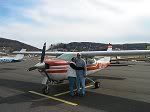 Both of the other Cardinals were there, so Yellowbird enjoyed a little family reunion. Sal brought his 1975 RG. I was looking forward to meeting both Sal and his Cardinal since we had missed each other at a previous flyin. The three-bladed propeller gives Two Niner Victor a sporty look.
Both of the other Cardinals were there, so Yellowbird enjoyed a little family reunion. Sal brought his 1975 RG. I was looking forward to meeting both Sal and his Cardinal since we had missed each other at a previous flyin. The three-bladed propeller gives Two Niner Victor a sporty look.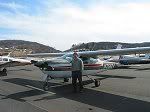 John arrived from Westfield in his 1976 RG. He had departed only a few minutes before Jamie and I did, but with 20 extra horsepower and wheels tucked neatly out of the breeze, he made better time than we did.
John arrived from Westfield in his 1976 RG. He had departed only a few minutes before Jamie and I did, but with 20 extra horsepower and wheels tucked neatly out of the breeze, he made better time than we did.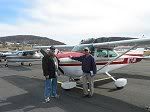 Jamie (right) and Pat (left) pose with Jamie's big Skylane. Jamie recently purchased Seven Four Hotel, and he's fitted her out with the latest avionics. That big 0-470 has the power to carry it all, but we know who has the prettier airplane, don't we?
Jamie (right) and Pat (left) pose with Jamie's big Skylane. Jamie recently purchased Seven Four Hotel, and he's fitted her out with the latest avionics. That big 0-470 has the power to carry it all, but we know who has the prettier airplane, don't we?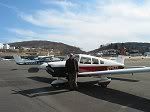 Dave brought his newly repainted Archer from Northampton. Sure, the wing is on upside down, but that fresh paint job really glows.
Dave brought his newly repainted Archer from Northampton. Sure, the wing is on upside down, but that fresh paint job really glows.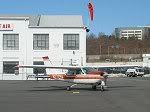 After walking off our lunches on the ramp, we said our goodbyes and prepared to put the tower controller to the test again. Sal was the first of the Cardinal Crew to leave the Reliant ramp, with Yellowbird following close behind, and John bringing up the rear.
After walking off our lunches on the ramp, we said our goodbyes and prepared to put the tower controller to the test again. Sal was the first of the Cardinal Crew to leave the Reliant ramp, with Yellowbird following close behind, and John bringing up the rear.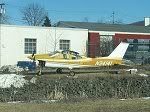 The only downside of the day was the sad sight of this rather inert 1972 FG, tied to the ground with its wings clipped. No airplane, particularly a Cardinal, should suffer like this.
The only downside of the day was the sad sight of this rather inert 1972 FG, tied to the ground with its wings clipped. No airplane, particularly a Cardinal, should suffer like this.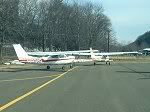 But, to make up for it, as we were approaching the runup area, another Cardinal RG, unrelated to our little get-together, joined the departure lineup behind Sal.
But, to make up for it, as we were approaching the runup area, another Cardinal RG, unrelated to our little get-together, joined the departure lineup behind Sal.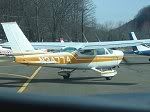 At this point we had Sal, Mystery Cardinal, Yellowbird, and John all in line for the same runway. A non-Cardinal Cessna separated Yellowbird from Sal and the stranger, and Jamie was between us and John behind. Otherwise, we could have treated the tower controller to the consecutive departures of four Cardinals!
At this point we had Sal, Mystery Cardinal, Yellowbird, and John all in line for the same runway. A non-Cardinal Cessna separated Yellowbird from Sal and the stranger, and Jamie was between us and John behind. Otherwise, we could have treated the tower controller to the consecutive departures of four Cardinals!Wednesday, March 23, 2005
An Unusual Arrival
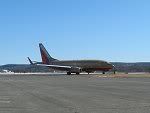 Yellowbird's home base, Westfield-Barnes Municipal (KBAF) is a relatively quiet class D airport. We do see a fair amount of bizjet traffic, and the 104th Fighter Wing of the Massachusetts Air National Guard flies A-10's from their base at the north end of the field, but apart from the occasional military transport, it's rare that we would see anything larger than a Citation or Falcon on our 9,000 foot runway. So, it was with some surprise that I noticed this unusual arrival on Saturday morning. One of Southwest Airlines' newer 737's (note the winglets) landed on 02 between 9:00 and 10:00. As I arrived just after 10:00 to meet up with some friends, I saw him taxiing down Bravo for departure.
Yellowbird's home base, Westfield-Barnes Municipal (KBAF) is a relatively quiet class D airport. We do see a fair amount of bizjet traffic, and the 104th Fighter Wing of the Massachusetts Air National Guard flies A-10's from their base at the north end of the field, but apart from the occasional military transport, it's rare that we would see anything larger than a Citation or Falcon on our 9,000 foot runway. So, it was with some surprise that I noticed this unusual arrival on Saturday morning. One of Southwest Airlines' newer 737's (note the winglets) landed on 02 between 9:00 and 10:00. As I arrived just after 10:00 to meet up with some friends, I saw him taxiing down Bravo for departure. 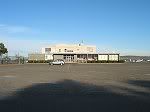 He was coming from the north end of the field, which makes me suspect that his visit may have been associated with the 104th FW. It's not unusual to see military units traveling by contracted civil airliner, but I don't recall hearing of any deployments by the 104th recently. Southwest already flies out of Bradley International (KBDL), only 15 miles south of Westfield, so I doubt that they are scoping out new fields to fly from. It would be nice, though, since I live within walking distance of Barnes. I could save a bundle on parking. But, even if they put in a jetway, I fear that our tiny terminal would be quickly overwhelmed by the arrival of even a little 737.
He was coming from the north end of the field, which makes me suspect that his visit may have been associated with the 104th FW. It's not unusual to see military units traveling by contracted civil airliner, but I don't recall hearing of any deployments by the 104th recently. Southwest already flies out of Bradley International (KBDL), only 15 miles south of Westfield, so I doubt that they are scoping out new fields to fly from. It would be nice, though, since I live within walking distance of Barnes. I could save a bundle on parking. But, even if they put in a jetway, I fear that our tiny terminal would be quickly overwhelmed by the arrival of even a little 737.
